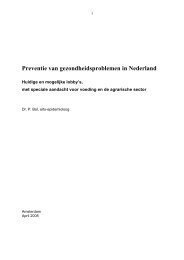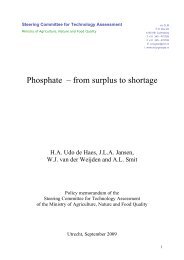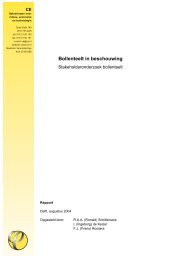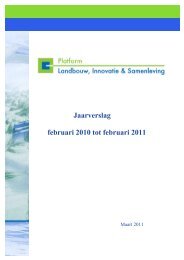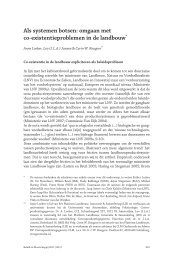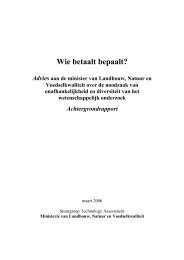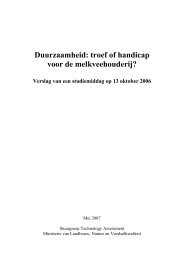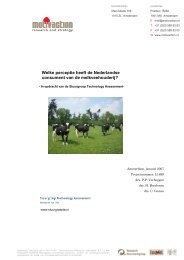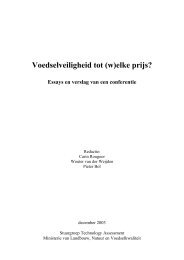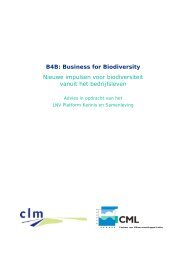De kwetsbaarheid van het Europese landbouw- en voedselsysteem ...
De kwetsbaarheid van het Europese landbouw- en voedselsysteem ...
De kwetsbaarheid van het Europese landbouw- en voedselsysteem ...
You also want an ePaper? Increase the reach of your titles
YUMPU automatically turns print PDFs into web optimized ePapers that Google loves.
Box Research questions for the knowledge and innovation ag<strong>en</strong>da<br />
Risk analysis<br />
1. Stress tests: to what ext<strong>en</strong>t is the European livestock sector resistant to calamities such as bioterrorism attacks?<br />
And which calamities, other than those referred to in this report, are rele<strong>van</strong>t to food security?<br />
And which are rele<strong>van</strong>t to food safety? What could be the consequ<strong>en</strong>ces of these calamities? In any case,<br />
these other calamities include power and/or Internet outages, food contamination in large chains and a crash<br />
of the financial system.<br />
2. What are the interactions betwe<strong>en</strong> the markets for food, raw materials, <strong>en</strong>ergy and capital? For example:<br />
to what risks are the other three markets subjected as a result of the massive creation of dollars and euros<br />
on the capital market?<br />
3. Which geopolitical sc<strong>en</strong>arios – besides those already explored as part of the interdepartm<strong>en</strong>tal programme<br />
Schaarste <strong>en</strong> Transitie (Scarcity and Transition) and the Strategie Nationale Veiligheid (the National Security<br />
Strategy) – are conceivable and what are the ad<strong>van</strong>tages and risks of these sc<strong>en</strong>arios for agriculture and<br />
food security in the EU and developing countries? And how can these risks be reduced?<br />
4. What is the nature and impact of the remaining levels of dumping in the US and EU? In how far can the<br />
European farm paym<strong>en</strong>ts be regarded as dumping? And the US practice of corporate dumping? Does the<br />
latter also occur in the EU? Which options are available for mutual reduction?<br />
Prev<strong>en</strong>tion<br />
5. The curr<strong>en</strong>t agricultural support of the EU primarily relies on farm paym<strong>en</strong>ts. The basis of this support is<br />
possibly too narrow since it does much less to protect food chains. Explore w<strong>het</strong>her the support can be expanded<br />
with support for chains that would <strong>en</strong>able them to be more resili<strong>en</strong>t to calamities.<br />
6. How can the production of protein crops in the EU and the Netherlands be promoted? In more concrete<br />
terms:<br />
• innovation of protein crops and production systems, for example through breeding and selection;<br />
• options for trade policy exchange with other products.<br />
7. What are the possibilities and limitations of the production of combined <strong>en</strong>ergy/protein crops? More<br />
specifically:<br />
• What are the sustainability pros and cons of various systems of combined <strong>en</strong>ergy/protein production?<br />
• Are there options for a flexible biofuel bl<strong>en</strong>ding obligation that can reduce severe price fluctuations for<br />
both grain and proteins, while also avoiding conflicts with trading partners?<br />
8. What are the possibilities (also in the area of trade policy) for a bl<strong>en</strong>ding obligation for European-grown<br />
vegetable proteins in animal feeds, with or without comp<strong>en</strong>sation for trading partners?<br />
9. What options are available to str<strong>en</strong>gth<strong>en</strong> the resili<strong>en</strong>ce of the European agriculture and food system<br />
with respect to calamities and geopolitics? Besides biological and technical options, this also concerns options<br />
in logistics, sector structure, farming styles and social networks. What new opportunities are offered by<br />
social media?<br />
10. More specifically: what are the options for str<strong>en</strong>gth<strong>en</strong>ing the resili<strong>en</strong>ce of the int<strong>en</strong>sive int<strong>en</strong>sive livestock<br />
farming in the Netherlands, which is relatively vulnerable to contagious animal diseases and a collapse of<br />
soya imports. How can the structure and magnitude of the sector be adapted in such a way that it becomes<br />
less vulnerable to animal diseases and a collapse of soya imports?<br />
Preparedness<br />
11. Where are the gaps in the public knowledge base of the EU and the Netherlands in the area of plant and<br />
animal diseases, also regarding new emerging diseases (such as Rift Valley fever and the wheat diseases<br />
stripe rust and yellow rust) and the risk of bioterrorism? How can access to vital knowledge be secured in an<br />
era of commercialisation?<br />
12. How can an ext<strong>en</strong>sification scheme combine reduced production with <strong>en</strong>vironm<strong>en</strong>tal and biodiversity b<strong>en</strong>efits?<br />
Can such a scheme be monitored for compliance?<br />
13. Does a flexible nitrog<strong>en</strong> levy have possibilities as a buffer? What are the possibilities and ad<strong>van</strong>tages/disad<strong>van</strong>tages<br />
from the perspective of sustainability?<br />
14. What are the costs and b<strong>en</strong>efits of various options for prev<strong>en</strong>tion and preparedness? These options include<br />
replacing soya imports with Europe-grown proteins, stockpiling and a set-aside scheme. Where are the optimalities?<br />
146



